Doopplebock beef recipe is not a dish, it is rather an intermediate step product to create a base of highly flavored beef and beef broth. They are both then used further to flavour stews, pilafs, risottos etc. Separated fat is used for cooking roasted potatoes, a great flavored addition to any roasted meat dish or even on its own as a snack. This simple preparation technique yields enough material sufficient for 8-10 servings of some of my favorite dishes.
One of key ingredients is a dopplebock beer. This kind of beer is typically characterized by malty and nutty flavors, high alcohol content and are low on hops, which affects bitterns. The bitterns is one of the biggest problems faced when cooking with beer and is caused largely by hops. As the cooking liquids are reduced and become concentrated they inevitably become bitter. This is avoided by use of dopplebock beer. One of the most suitable brands for this task and one that I used is German beer; Salvator from Pauliner. Originally made by Pauliner Monks of the Neudeck Monastery this is reportedly one of the best beers in the world. I can attest that it is wonderfully complex and has a full mouthfeel. After I tasted it I went back and bought everything that was left on the shelf.
Salvator is Pauliner’s flagship beer and at the same time the first brand the company brewed as it started back in 1634.

Other options include: Spaten’s Optimator or even few beers that are not dopplebocks as Spaten Dunkel (Germany) or Belhaven 90-Wee Heavy(Scotland).
The beef cut used is inexpensive and the product is delicious. It helps elevate the taste of other dishes it is added to. To prevent meat from drying out and to help controlling bitterns, crème fraîche is used. Do not use a sour cream, that would not be a good substitute. If you can not find crème fraîche or if you find it to expensive (which it often is) you can make your own. Just take heavy cream (35% B.F.) pour it in a glass jar,and add 2 tbsp of buttermilk or yogurt per cup of cream. Mix well, cover with cheesecloth and let it sit on a counter 24-48 hours, depending on the room temperature. Store refrigerated.

At the end of the process you will end up with three items:
- Separated fat
- Beef broth
- Flavoured beef
Separated fat can be used for a delicious roasted potato recipe (the following blog post). Beef and beef broth can be kept frozen for several months. Defrost few slices of beef at a time and use as a highly flavoured component to future recipes. Applications include: risotto, pilaf, ragùs and pasta dishes, soups, stews etc.
The recipe has been adapted from chef Greg Easter and his book “Cooking in Russia”.
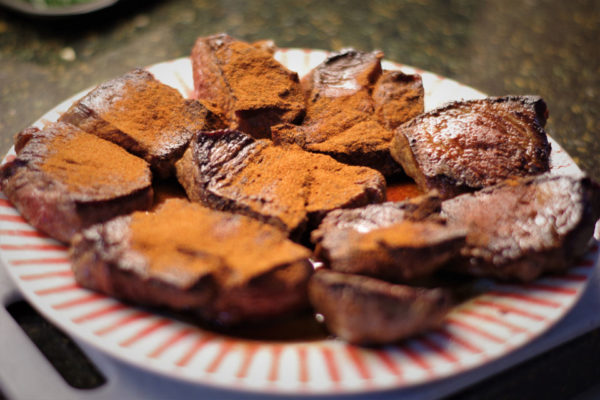
| Prep Time | 15 min |
| Cook Time | 2 hrs |
| Passive Time | 30 min |
| Servings |
servings
|
- 700 g beef sirloin or chuck cut in 12 mm (1/2") steaks
- 90 g onions sliced into rings
- 2 tsp paprika bittersweet preferred, but sweet will work too
- 4-5 garlic cloves chopped in half
- 1 rosemary spring fresh
- 2 tbsp Creme Fraiche
- 160 ml dopplebock beer
- coarse sea salt
- 1-2 tbsp extra virgin olive oil
Ingredients
|

|
- Bring the steaks to room temperature and dry them out with paper towels. Sprinkle some coarse salt over steaks.
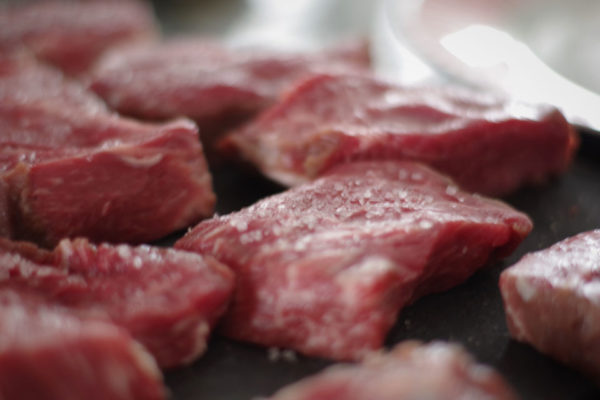
- Preheat non stick skillet over medium heat (5 out of 10). Skillet has to be very hot, about 200ºC (400ºF). Add olive oil and sear steaks in batches, do not overcrowd them. Leave the steak for 5-7 minutes on one side before turning it over and cooking for another 3-5 minutes on the other side.
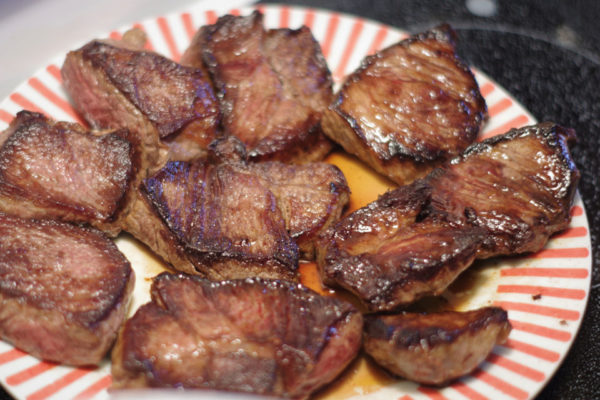
- As steaks are seared add olive oil as needed, do not let the skillet become dry.
- After all the steaks are cooked and removed to a plate, add the beer to the skillet, scrape the bottom of the pan and deglaze it.
- Pour off deglazed liquid into a pressure cooker and bring to simmer over medium heat (5 out of 10).
- Add in onion rings and let cook for couple of minutes till softened up.
- Sprinkle 1 tsp of paprika over the top of browned steaks. Steaks should be placed in one layer and you will sprinkle paprika only on the top side.
- Add the garlic cloves to the pressure cooker.
- Add the steaks to the pressure cooker, placing the paprika seasoned side down. Pour in any juices from the plate, released by the meat. The steaks should be placed in one layer in the pressure cooker.
- Sprinkle 1 tsp of paprika on top of the steaks.
- Add in fresh rosemary sprig and creme fraiche.
- Close the pressure cooker, bring it up to pressure over high heat and than reduce heat to low (1.5-2 out of 10). Cook for 1.5 hours at pressure.
- Turn the heat off and leave pressure cooker for another 30 minutes before opening the lid.
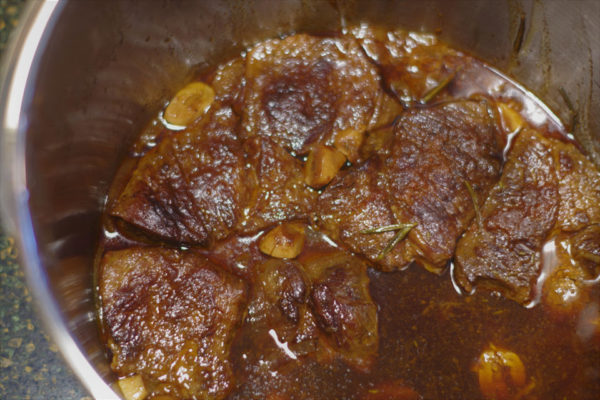
- Carefully remove the meat and set aside.
- Pass the liquid through the sieve. Cover with plastic film and leave in refrigerator overnight.
- The next day separate the fat from the broth and store for future use.
- Select well marbled piece of beef and remove any connective tissues before cutting into steaks.
- Cross cut the meat grains when cutting out the steaks. That is the way to shorten the grains or muscle fibers which will make steaks more tender at the end.
- To produce meat browning and consequently create intense flavour (Millard reaction) the searing heat has to be above 150ºC (300ºF). Water can not be heated above 100ºC (212ºF) and that is why the meat is first dried out before searing.
- The goal is to achieve deep brown caramelization on stakes, and not to burn them.


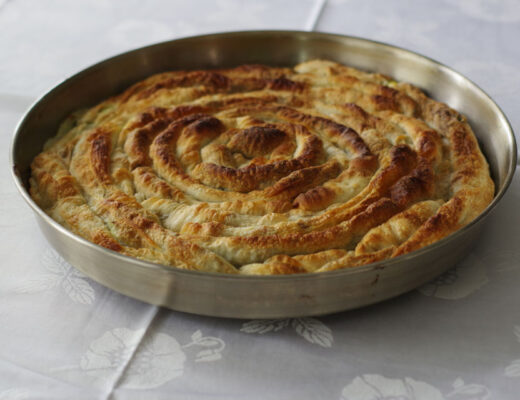
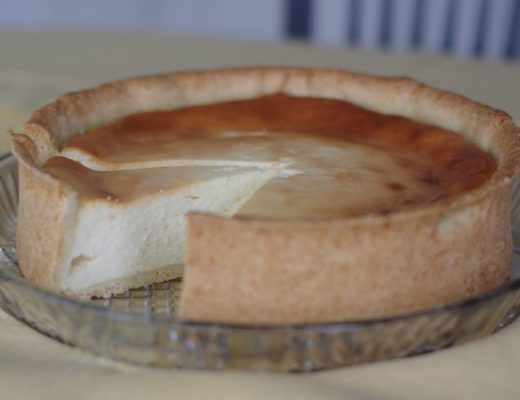
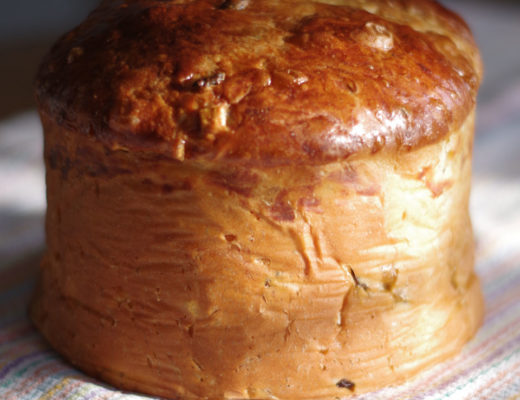
No Comments